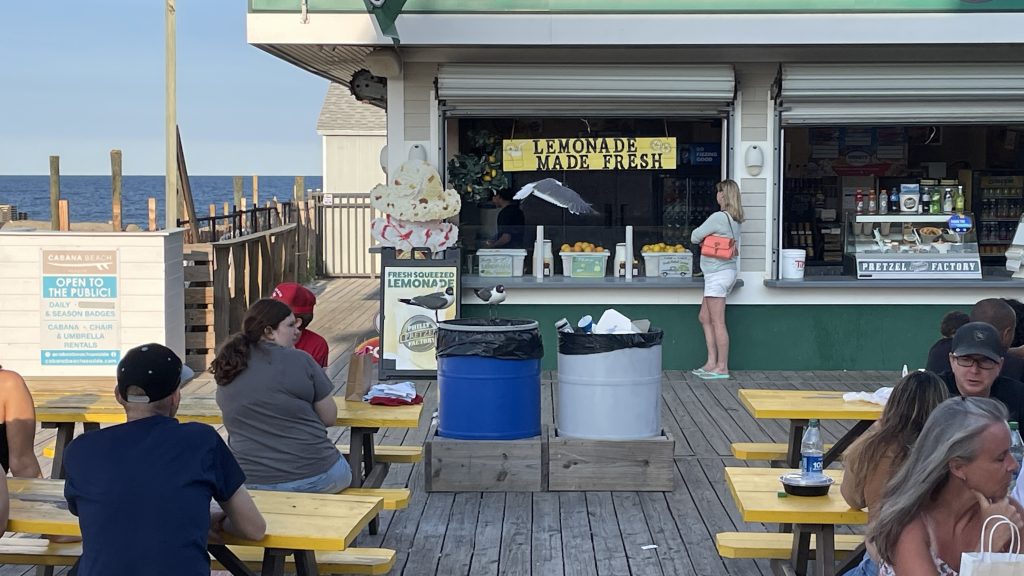The south end of the Seaside Heights boardwalk is one of the most successful post-Sandy reconstruction projects in the state. First pummeled by the storm, then finished off by the 2013 boardwalk fire, entrepreneurs who stepped in to rebuild have attracted dozens of cuisines in an outdoor food court, from Cuban specialties, to boutique mac-and-cheese, to the venerable boardwalk cheesesteak. Old favorites like Three Brothers pizza are in the mix as well.
With the increased number of dining options, outdoor tables and crowds flocking to the freshly-built maze of kiosks have also come flocks of seagulls that regularly land on the tables, snatch items from trash cans, feast on any morsel they can find, and occasionally “dive bomb” a tourist’s meal the second they look away. The proliferation of birds has raised health concerns among some, and nuisance concerns by others. (The video embedded above this story captured birds on tables and rummaging through trash bins. Ad blocking software may interfere with its appearance.)

Seagulls converge upon outdoor dining areas in Seaside Heights, N.J., Aug. 2, 2023. (Photo: Shorebeat)

Seagulls converge upon outdoor dining areas in Seaside Heights, N.J., Aug. 2, 2023. (Photo: Shorebeat)
Logically, it was bound to happen – nobody can eliminate seagulls from the beach, after all – but a growing number of coastal resorts that have expanded outdoor dining options in recent years have turned to creative means of shooing away the winged pests. The options, however, do not come cheap.
“Ocean City paid over $300,000 to have falconers come in and chase the gulls away,” said Borough Administrator Christopher Vaz, who briefed the borough council on the growing issue Wednesday. “It’s very effective, but it’s a bit out of our price range here. I met with a company this week to talk about other strategies.”
In Ocean City’s case, the city has, indeed, found success with hiring a team of professional falconers to bring their raptor friends to the boardwalk to keep the gulls in line. East Coast Falcons, based in Lodi, N.J., deploys a team of handlers that release two trained Harris’s hawks, eight falcons, eight back-up falcons and “Ozzy the owl.” The program has been such a success that this year, the city expanded the company’s contract to the downtown area.
Ocean City Mayor Jay Gillian initiated the program in 2019 after video went viral of a gull “smacking” a small child in the face, according to OCNJDaily.
The birds of prey are trained not to attack the gulls, but instead provide area-denial, chasing them back to their natural habitat on the sand and in the bay areas where there is plenty of natural food available. The birds have also become something of a tourist attraction themselves, with the falconers welcoming questions from visitors and allowing tourists to get a look at the birds of prey when they land on their handlers’ shoulders.
In Seaside Heights, however, price will likely have the borough looking to other alternatives. One of those is the “Eagle Eye” bird deterrent system, an optical device placed on a monopole – or a network of monopoles – that spins and produces a dazzling light reflection that deters gulls from coming closer. The manufacturer of the system says the devices are harmless to the gulls, are silent and wind-powered.
“The light spectrum reflected back by the Eagle Eye and Flash Flag disorient birds in flight by limiting their vision significantly,” the company, BirdBarrier, states on its website.
“We have a few residents in town who actually have them on their homes,” said Vaz.

Seagulls converge upon outdoor dining areas in Seaside Heights, N.J., Aug. 2, 2023. (Photo: Shorebeat)
There are other options as well, with mixed reviews.
“Other towns have tried stringing things like fishing line – that doesn’t sound as attractive for us – and then there are audible systems that are supposed to deter them,” Vaz said.
Bird Problem or People Problem?
Many a visitor has chuckled over a seeing a seagull break into the beach bag of someone away from their chairs swimming, only to crack open a potato chip bag and have a feast. On occasion, it’s comical, but too many gulls congregating in one area can create real concerns, ranging from health to litter. In a span of less than 15 minutes, a Shorebeat reporter saw gulls land on tables where patrons were having dinner, pick items out of trash cans and leave them on the boardwalk, and aggressively fight over a piece of bread.
“It is a problem,” said Vaz. “If you’re sitting there having a slice of pizza and turn your head, the pizza may be gone.”
The issues, however, cannot be completely blamed on the birds, he said.
“Part of the problem is that people condition the seagulls to interact with humans,” said Vaz. “Every time someone feeds a seagull in violation of the ordinance, it creates a memory in the bird’s head – they’re not stupid animals.”

Seagulls converge upon outdoor dining areas in Seaside Heights, N.J., Aug. 2, 2023. (Photo: Shorebeat)
Seaside Heights does ban the feeding of wildlife and can impose a fine on those who do, but the ordinance can be difficult to enforce, and if applied aggressively, could take police and code enforcement officers’ attention away from more pressing calls.
Whether the borough can work its magic to attract a falconer, or deploy one or more of the alternative systems on the market, borough officials said the issue of the gulls’ overabundance has been noted, and something will be done about it.
“I’m not sure what the solution will be, but we’re talking to a consultant, and we’re going to nail something down,” Vaz said.

Advertisement

Ortley Beach & North Beaches
Landmark Ortley Beach Breakfast Spot Looks to Expand

Ortley Beach & North Beaches
‘Temporary’ 70-Foot Cell Tower on Route 35 in Ocean Beach OK’d to Return

Seaside Heights & Seaside Park
Beloved South Seaside Park Restaurant Will Remain Open As Developer Seeks to Demolish Block

Seaside Heights & Seaside Park
In Seaside Heights, A $50M Flagship Building Rises Over the Boulevard in a Famed Location

Police, Fire & Courts
Ocean County Sheriff Establishes Drone Command Center in Seaside Heights Amid New Video





